
Geoff Boxell
Interests: Anglo-Saxon history, Norman Conquest, 100 Years War
Archery, writing articles, stories and novels, lecturing and giving talks on English history for the University of Waikato's Continuing Education Programme.
Sometimes know as one of the following:
Wulfhere tha Saxon

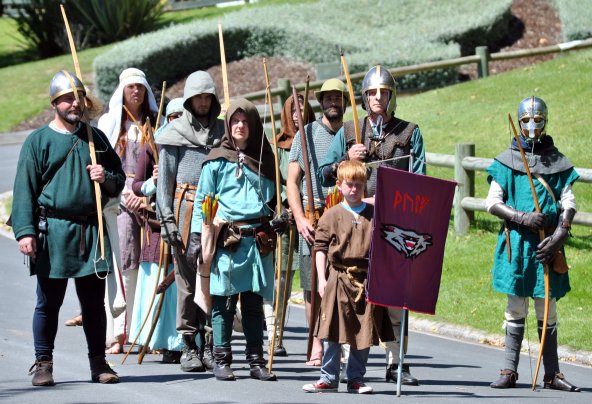
Wulfhere the Saxon, is a mercenary archer who has fought both for and against Romans, Britons and Gauls, depending on who was offering the best pay for him and his band.
In time Wulfhere moved from his home base in the Saxon lands bordering Anglehelm to a base on the South Saxon Shore of Britannia opposite Gaul. The base was provided by his then Roman employers. Following the collapse of Roman power in Britannia, Wulfhere took advantage of the invasion of the land by fellow Saxons Ælle and his 3 sons, Cymen and Wlencing and Cissa with their warbands.
Wulfhere has finally settled on land taken from the Waelesa at Wulfington in the Weald in the kingdom of the South Saxons that Ælle established. Wulfhere, to his dying day, was unable to grow a beard. As a joke behind his back he was known as Wulf Beard. After his death his holding was know as Wulfbearding (now Woolbedding).
During his time on the Saxon Shore, Wulfhere took Lyina to wife; her father was a Waelas and her mother a Jute.
Wulfhere’s constant companions are his nephew Wulfwyne, his sister Swanhild’s son. Amongst the Saxons a sister’s son is the closest relation a man can have, and his grandson Herewulf, son of Wulfstan. There are times when Wulfhere’s sons, Wulfric, Wulfstan and Wulfbald jibe at the closeness of Wulfhere and Wulfwyne.
Wulfhere’s sons manage the family holding whilst often joining Saxon warbands seeking new lands to be taken from the Waelesa. They hope to be rewarded by their king with land of their own to hold. Wulfhere and Wulfwyne are still frequently away within and without the lands of the Angleish with their band of mercenaries. Whilst Wulfhere is happy to fight against fellow Saxons for Angle or Jutish paymasters, or Angles and Jutes on behalf of the Saxons, he will not fight any of the folk on behalf of the Waelesa. He will, however, hire himself to princes of the Waelesa to fight any other peoples, such as the Picts or Irish, or even rival Waelas princes.
Godfrew of Garratt, in the Brixton Hundred, Surrey. A dispossessed thane, known to his Norman enemies as Wulf
Wulf fought on Senlac Ridge in 1066 against the invasion lead by William the Bastard, Duke of Normandy. Because of this he was disinherited and his holding of Garratt was given to one of William’s stable boys. A rare survivor of the battle near Hastings, Wulf fought in many skirmishes against the Normans and their mercenaries being in the service of both Edric the Wild, during which time he took part in the Battle of the Reeds at Ely alongside Hereward the Wake, and Earl Ralf of East Anglia. Prior to Ralf’s final revolt Wulf left his service and went to live with his Uncle Edwin, the brewer of Battersea.
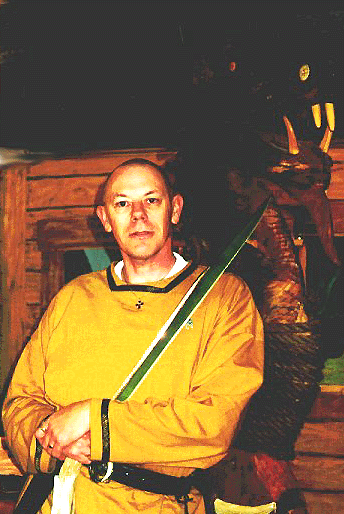
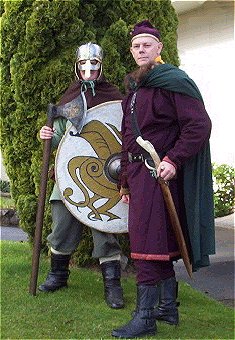
Grimm Wendlewulf.
An old one eyed story teller who turns up uninvited to banquets.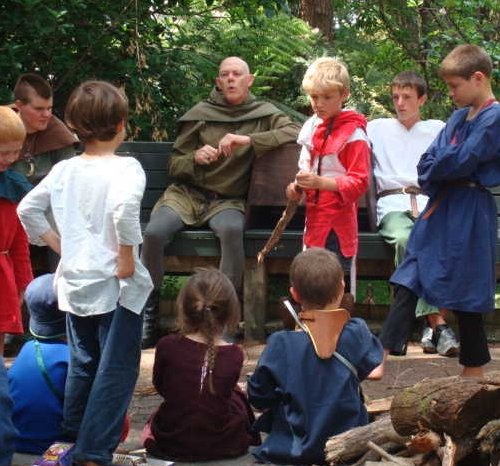

Geffrey đe Wulf of Half-farthing in the Brixton Hundred, County of Surrey: mounted archer in the household of Sir Alan de Buxhall KG of Salehurst in Sussex, Constable of the Tower of London for Edward III and Richard II, by the Grace of God, King of England, and France, Lord of Ireland & Overlord of Scotland.

Personal badge of
Geffrey đe WulfGeffrey đe Wulf
(or Wolf)Geoffrey is a yeoman and he serves as a Mounted Household Archer (Special Duties) to Sir Alan de Buxhall, Knight of the Garter, King’s Councillor, King’s Chamberlain, Constable of the Tower of London to King Richard II, King of England & France, Lord of Ireland & Overlord of Scotland (see http://lynboxell.tripod.com/siralan.htm).
Geffrey was born in 1313 at Battersea, Parish of St Mary, in the Brixton Hundred, County of Surrey. Originally destined to follow the family trade as a brewer, Geffrey stood as his father John’s replacement archer at the Hundred Array of Arms from the age of 15 whence he was recruited by his distant relative, Sir Allan de Buxhall of Salehurst, Sussex, to serve with him as a Yeoman Archer for King Edward III in the Flanders Campaign of 1339-40 against the French. Whilst in later years Geffrey spent most of his time on garrison duty at St Sauver, from 1342 to 1356 he fought in the battles of Morlaix, Auberothe, Siege of Calais and Poiters (see http://lynboxell.tripod.com/Petters.htm). He also took part in three chevauchee. In 1351 he was part of the body of archers who took part in the crusade in Prussia alongside the Teutonic Knights.
Given his proven abilities Geffrey became one of Sir Alan’s Household Archers from 1346. Since August 1375 Geffrey has been based at The Tower of London. Rather than standard garrison duty, Sir Alan tends to use his “cousin” for “special duties”. Many of these duties Sir Alan does not want to officially recognise. An example of this was the extraction by Sir Alan, with non-retained archers provided by Geffrey, of two escaped prisoners from the Tower of London from sanctuary at Westminster Abbey (see https://geoffboxell.tripod.com/SCA/HuntingtheWren.htm). An earlier example was investigating the problem of war bows breaking (see http://lynboxell.tripod.com/scotfree.htm). To meet the need for discretion, Geffrey has a large selection of livery outfits, few of which he is entitled to actually wear. Amongst his collection are the liveries of The City of London Night Guard, King Richard III’s bodyguard of Cheshire Archers, Baron Fulk de Cherbourge, Mercer’s Guild, the Duke of Lancaster, the Duke of York, the Earl of Essex and Sir Alan de Buxhall.
As a young man Geffrey was considered a ‘marksman’ archer and 1318 won the County archery contest against stiff opposition scoring highest marks at both round and the wand. Regrettably, as a result of war service, Geffrey is no longer so accurate. At the siege of Rheims, in 1360, he was hit in the face by a sword whilst storming the city and lost the sight in his left eye as a result. At the siege of St Saveur le Vicomte, in 1375, he was captured whilst taking a message from the besieged Sir Thomas Catterton to Sir Alan de Buxhall, who was attending King Edward III at Court in England at the time. The French attempted to mutilate Geffrey by cutting off the string fingers on his right hand. Quick thinking, and the arrival of an English scouting party, meant that he only lost the first joint of the index finger on his right hand. The combined injuries meant he was no longer capable of being a front line archer and Sir Alan de Buxhall found him a position in the Tower of London garrison.
In addition to the distant family connection, Sir Alan de Buxhall’s affection for Geffrey comes from him helping to save Sir Alan’s life when was attacked by soldiers lead by Thomas Lound, who had been Sir Alan’s lieutenant of the castle of Clinchamp, Maine. Sir Alan had made an investigation into alleged abuses at King Edward’s request and as a result Lound had been dismissed for “oppressions against the local population”. Later Sir Alan sued Lound for damages and for compensation for goods he said Lound had stolen.
With money earned and gained during the French wars Geffrey bought the tenancy of Half Farthing Manor, Wandsworth parish of All Saints, Brixton Hundred, County of Surrey in 1345 and in 1347 added a three-generation lease on land at Garratt, which abuts Half Farthing. He also has a minor interest in the Lampit Corn Mill, which is the final water mill on the River Wandle before it meets the Thames at Wandsworth.
Geffrey is descended from Moithar, the middle son of Godfrew of Garratt, otherwise known as Wulf. Wulf fought on Senlac Ridge in 1066 against the invasion lead by William the Bastard, Duke of Normandy. Because of this he was disinherited and his holding of Garratt was given to one of William’s stable boys. A rare survivor of the battle near Hastings, Wulf fought in many skirmishes against the Normans and their mercenaries being in the service of both Edric the Wild, during which time he took part in the Battle of the Reeds at Ely alongside Hereward the Wake, and Earl Ralf of East Anglia. Prior to Ralf’s final revolt Wulf left his service and went to live with his Uncle Edwin, the brewer of Battersea. Geffrey has taken much pleasure in regaining control of Garratt, albeit only part of it and on a three generation lease.
Geffrey is married to Lucy á Becket, the daughter of a London merchant who was member of the Mercer’s Guild. Due to the regular absences that Geffrey’s service with Sir Alan cause, his wife and their eldest son, John, manage the farm.
Geffrey has also made enough money to buy four houses in the city of London and a livery stable in Westminster. The stables are run by the wives and children of his two younger sons, Matthew and Thomas, who spend most of their time as archers in various English garrisons in Normandy and Gascony. None of the above are in Geffrey’s name as that would make his taxable value that of an esquire, and he does not want the added responsibilities of that rank: he is quite comfortable with the status of a yeoman.
Frequently in Geffrey’s company is his nephew, Gareth Robertson, whose father, Geffrey’s younger brother Robert, is the miller at Waddon, near Croydon as well as having a small holding at Wallington. Robert and his family, like Geffrey’s family, are Lollards. As with most folk of yeoman stock, they are all literate and appreciate reading the bible in English as well as other writing such as “Piers Ploughman”, “The Cloud of Unknowing”, “Richard the Redeless”, “Mum and the Sothsegger” and “The Crowned King”. In addition to these Lollard tracts Geffrey has more than one Robin Hood ballad together with some of the less scurrilous tales by Geffrey Chaucer, the comptroller of the customs for the port of London, for whom he has, unofficially, done some debt collecting – the writings, together with some tuns of best Bordeaux red being his commission. Gareth has a “well thumbed” copy of “Sir Gawain & the Green Knight”, whilst his sister, Gwen, has part of “Confessio Amantis” which, despite its title, is in English. The family holdings at Wallington, Waddon, Garratt and Half Farthing are connected by the valley of the River Wandle. The miller’s trade and the need to market surplus farm produce in London allow the Wulf family group to collect and distribute Lollard tracts and copies of bible scripture that has been translated into English to fellow believers. As Lollardy is considered to be heretical those who subscribe to its principles do not make a demonstration of their faith and the loose knit group of followers operate “underground” using signs and passwords to provide security. Whilst believing in the basic Christian principles that Lollards follow, Geffrey is too cautious to adhere to the more radical teachings of some of the hedge priests such as John Ball (see https://geoffboxell.tripod.com/SCA/Ball.htm).
The connection of the Buxhall family with the house of Lancaster is providential for Geffrey, as the tacit support of John of Gaunt, Duke of Lancaster, for John Wycliffe, and thus for the Lollards, mean that Geffrey and his family group who, like Sir Alan, belong to Lancaster’s affinity, are able to avoid too close a scrutiny by the established Church authorities, despite the Waddon mill being owned by the monks of Bermondsey.
For relaxation Geffrey enjoys hunting deer and often takes fellow Tower of London garrison friends with him. Normally he hunts in Melchet Wood, of which Sir Alan has been Warden since 1370. He denies rumours that he also hunts in Epping Forest and Hainault Forest. These forests are Royal Forests and therefore hunting there would be illegal. Whilst Geffrey has been seen in the Royal Forests with bow and arrow it is only at the request of the Crown in order to cull poor quality animals before a visit by the King in order to ensure that any hart driven into the hunting hurst is worthy. Alternatively he sometimes takes deer that are a gift from the King to Sir Alan for his personal use.
In addition to being a competent archer, Geffrey is also skilled in the use of short sword and buckler. Geffrey’s war belt carries three blades: Mildred, a long fighting knife given to him by his father when Geffrey became the family representative at the array of arms; Wendle, a small eating seax which is a family heirloom once owned by Godfrew of Garratt; The Wren, a short sword presented by Sir Alan for Geffrey’s help in the incident at Westminster Abbey. In addition to his steel buckler, Geffrey has a hardened leather show buckler. Commissioned by Sir Alan from Edward Braythwayte, the trader and artisan, it was presented as a gift to Geffrey for solving the problem of the broken war bows. The buckler shews a wolf rampant facing Sir Alan’s arms of “or, a lion rampant, azure, fretty argent”. The edge of the buckler bears the legend: “The Lord is my Light and my Salvation – Whom Should I Fear?” being the first lines of Psalm 27.

The king ordered for the City of London nightly guards and marching watches: coats of white fustion signed on the breast and back with the arms of the city
|
|
|
|
|
Service record for Geoffrey Wulf:
|
1339-40 |
Flanders Campaign |
Duke of Lancaster |
|||||||||
|
1342 |
Fought in Battle of Morlaix |
Duke of Lancaster |
|||||||||
|
1345 |
Fought in Battle of Auberothe |
Duke of Lancaster |
|||||||||
|
1345-47 |
Brittany Campaign |
Duke of Lancaster |
|||||||||
|
1346 |
Siege of Calais |
Duke of Lancaster |
|||||||||
|
1349 |
Chevauchee to Toulouse |
Duke of Lancaster |
|||||||||
|
1351 |
Crusade to Prussia with Teutonic Knights |
Duke of Lancaster |
|||||||||
|
1355 |
Chevauchee though Normandy |
Duke of Lancaster |
|||||||||
|
1356 |
Fought at Battle of Poitiers (messenger from Duke of Lancaster's army in Brittany) |
Edward Prince of Wales |
|||||||||
|
1357-59 |
Garrison duty, St Sauveur, Normandy |
Sir John Chandos (Sir Alan Buxhall Keeper & Captain) |
|||||||||
|
1360 |
Siege of Rheims |
Duke of Lancaster |
|||||||||
|
1360-69 |
Garrison duty, St Sauveur, Normandy |
Sir John Chandos (Sir Alan Buxhall Keeper & Captain) |
|||||||||
|
1373 |
Grand Chevauchee |
Duke of Lancaster
|
1374-75
|
Garrison duty, St Sauveur, Normandy
|
Sir John Chandos (Sir Alan Buxhall Keeper & Captain)
|
1375
|
Siege of St Sauveur
|
Sir Thomas Catterton (Sir Alan Buxhall Keeper & Captain)
|
1375-81
|
Special Duties. Garrison of the Tower of London
|
Sir Alan Buxhall KG, Constable of the Tower |
In recent times Geffrey is often seen accompanied by his nephew Gareth and his niece Gwyn (Guinivieve).

They are the son & daughter of his younger brother, Robert.
Background to the: " Wulfing Household"
For information, stories and pictures of Geffrey's Household: "The Wulfings".

Badge of Sir Alan de Buxhall
Alan de Buxhall (or Buxhull, Boxill, Buxschal, Boxscel, Bocksel etc) Knight of the Garter

Livery badge of King Richard II
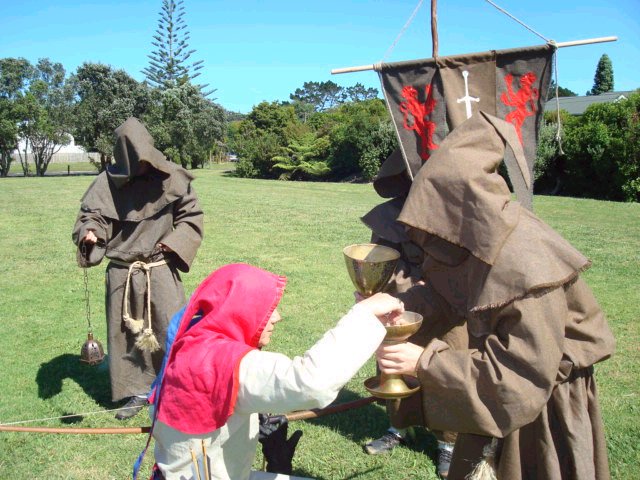
Lollards still need to be seen by the Church Established to participate in its sacraments if they are to survive.
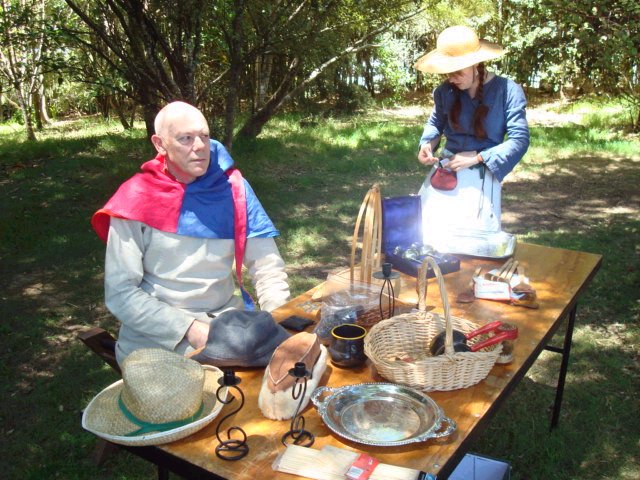
The honest trader.
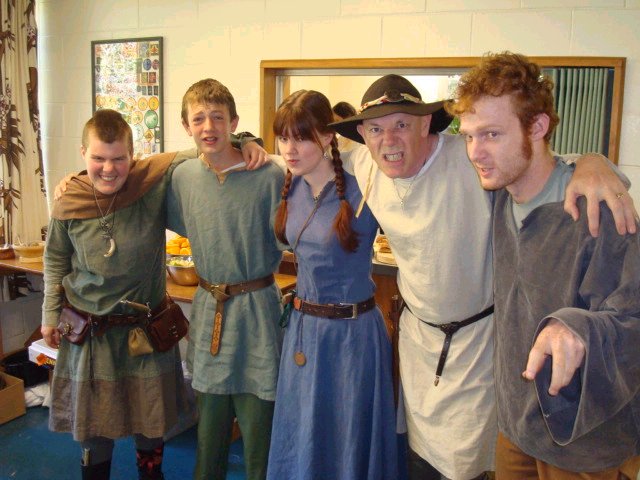
Someone has upset the Wulfings!
Perhaps they didn't like our singing?

The blessing of our banner of St Eadmund King & Martyr at St Peter's Cathedral